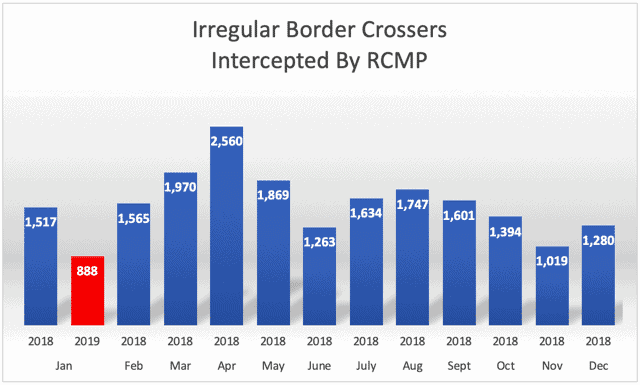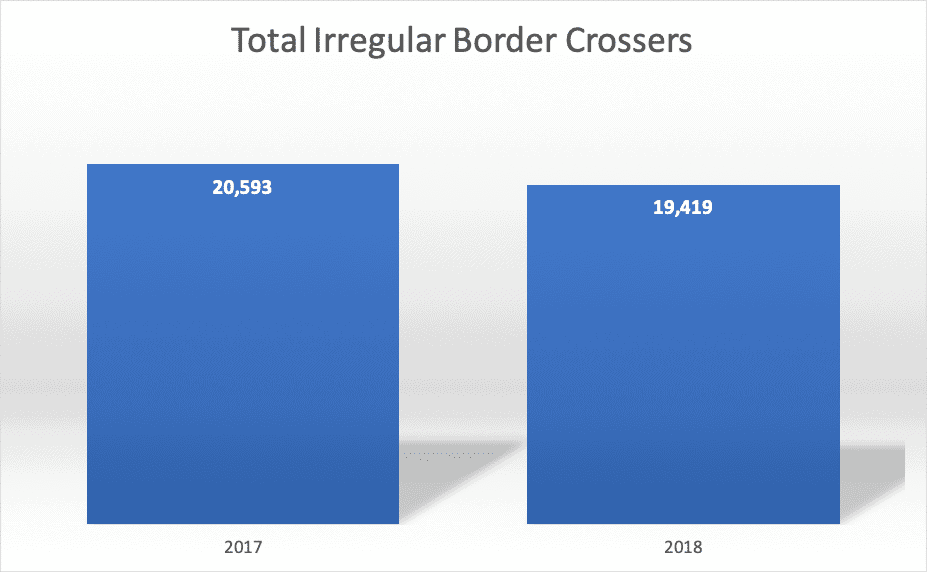March 12, 2019 – Fewer than 1,000 irregular border crossers were intercepted coming from the U.S. to Canada in January, marking the first time the figure has dropped below four figures since June 2017.
The first month of 2019 saw 888 people intercepted by RCMP officers, compared to 1,280 the month before and 1,517 in January 2018.
Canada’s federal government will be hoping the reduction continues throughout the year given the politicization of the issue by opponents to the Liberals ahead of November’s election.
The test will come as the weather warms and conditions become less treacherous for those motivated to cross the border at unrecognized points.
The vast majority cross into Quebec into Saint-Bernard-de-Lacolle, with 871 out of 888 entering into the French-speaking province in January.

January’s figure comes after 19,419 asylum seekers were intercepted in 2018, compared to 20,593 in 2017.
Canada’s asylum system is now choked to the point where claimants are waiting two years to have their cases heard.
The Immigration and Refugee Board, which hears asylum cases, has 64,000 claims awaiting a decision. Nearly 35,000 of these claims are from irregular border crossers from the U.S.

In a federal election year, the opposition Conservatives are painting the situation as a crisis, while Liberal officials say they are confident the issue can be dealt with via increased resources for the IRB.
The influx of irregular border crossers began in summer 2017, when U.S. President Donald Trump first threatened the Temporary Protected Status of thousands of Central and South Americans.
July and August 2017 saw the most irregular border crossers in the last two years, with 3,134 and 5,712 respectively crossing the border at unrecognized points.
Read More
Immigration Minister Confident Asylum Backlog Can Be Tackled
Irregular Border Crossers Flooding into Canada Costing Taxpayers Millions
Thousands of Americans Crossing Canada Border as Asylum Seekers Flee Trump Policies
Canada’s 2018 Irregular Border Crosser Numbers Eclipse First 9 Months of 2017
Trump has continually said he would end TPS status for specific nationality groups. TPS is given to people from countries affected by war or environmental disasters, as part of a program established in the 1990s.
The overwhelming majority of those crossing the border have flooded into Quebec, where provincial officials have called on the federal government to pick up the bill for expenditure related to the issue.
The federal government is spreading those that arrive out across Canada to try and ease the burden on the French-speaking province.
However, out of the 19,419 who arrived in 2018, 18,518, or 95 per cent, came into Quebec, mainly via crossing point at Saint-Bernard-de-Lacolle.

Government efforts to tackle the problem have centred around an information campaign.
The central message is that there is no guarantee of being allowed to stay in Canada for those crossing the border.
The border crossers choose to cross at unrecognized points due to the Safe Third Country Agreement.
The agreement says asylum seekers must apply for refugee status in the country where they land.
As a result, if the so-called irregular border crossers presented themselves at recognized border crossing points, they would be turned away.
Many are therefore blaming the agreement for forcing would-be asylum seekers to cross at unrecognized points.
Canada’s Immigration and Refugee Protection Act requires the countries considered ‘safe’ to be continually reviewed.
A recent independent review highlighted several problems with an asylum system that has historically failed to cope with claim spikes, causing a growing backlog.
An important recommendation of the review was to bring it under the authority of the immigration minister, although many are keen for it to remain independent.
Changes are yet to take place in response to the recommendations, with the IRB given time to tackle the problems on its own.
It recently announced a task force to focus on less complex cases, and established an asylum management board to speed up processing by improving co-ordination.
Interested employers: Kindly contact us here to receive further information.
Interested candidates: Find out whether you qualify to Canada by completing our free on-line evaluation. We will provide you with our evaluation within 1-2 business days.
Read more news about Canada Immigration by clicking here.





